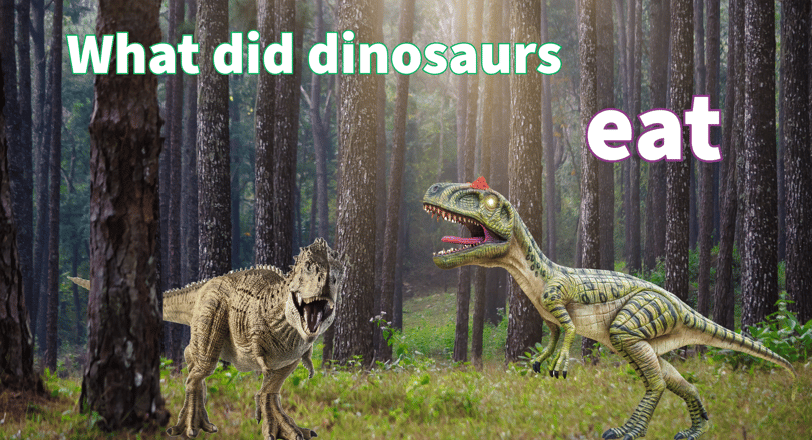What did dinosaurs eat, and how do we know?
Dinosaurs, the diverse group of reptiles that dominated Earth for over 165 million years during the Mesozoic Era, exhibited a wide range of dietary habits. These diets were dictated by their species, ecological niches, and available resources.
ENGLISHGENERAL KNOWLEDGE


Dinosaurs, the diverse group of reptiles that dominated Earth for over 165 million years during the Mesozoic Era, exhibited a wide range of dietary habits. These diets were dictated by their species, ecological niches, and available resources. By studying fossils, modern scientists have reconstructed much of what is known about their feeding behavior, revealing that dinosaurs could be herbivorous (plant-eating), carnivorous (meat-eating), or omnivorous (eating both plants and animals).
Herbivorous Dinosaurs
Examples of Herbivorous Dinosaurs
Many dinosaurs were herbivores, relying on the lush vegetation of their era. Notable herbivores include:
Sauropods: Long-necked dinosaurs like Brachiosaurus and Diplodocus that consumed leaves and vegetation from treetops.
Ornithischians: Dinosaurs like Triceratops, Stegosaurus, and Ankylosaurus that fed on low-lying plants and shrubs.
Hadrosaurs: Duck-billed dinosaurs capable of grinding tough plant material with specialized teeth.
Evidence for Herbivory
Teeth and Jaws: Herbivorous dinosaurs often had flat, broad teeth suitable for grinding plant material. Sauropods, for instance, had peg-like teeth ideal for stripping leaves, while hadrosaurs had complex dental structures for chewing fibrous plants.
Fossilized Stomach Contents: Some fossils preserve remnants of the dinosaurs' last meals. For instance, fossilized gut contents of some sauropods reveal traces of conifers, cycads, and ferns.
Coprolites (Fossilized Feces): Coprolites from herbivorous dinosaurs contain fragments of plant material, including seeds, leaves, and wood.
Biomechanics and Jaw Function: The structure of skulls and jaws provides insights into their feeding mechanisms. For example, Triceratops had powerful jaws and beak-like mouths suited for cutting tough vegetation.
Vegetation Availability
During the Mesozoic Era, Earth's plant life included cycads, ferns, horsetails, conifers, and later, flowering plants (angiosperms). The distribution of these plants influenced the dietary patterns of herbivorous dinosaurs.
Carnivorous Dinosaurs
Examples of Carnivorous Dinosaurs
Carnivorous dinosaurs were primarily theropods, a group characterized by sharp teeth and claws. Examples include:
Tyrannosaurus rex: A massive predator known for its bone-crushing jaws.
Velociraptor: A smaller, agile hunter with sharp claws.
Allosaurus: An apex predator of the Jurassic period.
Evidence for Carnivory
Teeth and Claws: Carnivorous dinosaurs had serrated, blade-like teeth ideal for slicing flesh. Their claws were sharp and curved, enabling them to grasp and subdue prey.
Fossilized Bones: Fossils often show evidence of predation or scavenging, such as tooth marks on bones or partially consumed remains.
Stomach Contents: Fossilized remains of prey animals have been found inside some carnivorous dinosaurs. For instance, a Velociraptor fossil was discovered entangled with its prey, suggesting active predation.
Coprolites: Carnivorous coprolites often contain bone fragments, indicating a diet rich in meat and bones.
Hunting Adaptations: The body structure of theropods, such as their forward-facing eyes (for depth perception) and strong legs, suggests they were effective hunters.
Omnivorous Dinosaurs
Examples of Omnivorous Dinosaurs
Some dinosaurs had more generalized diets, consuming both plant and animal matter. Examples include:
Oviraptor: Once thought to be an egg thief, this dinosaur is now believed to have had a varied diet, including plants, eggs, and small animals.
Troodon: A small theropod with features suggesting both carnivorous and herbivorous tendencies.
Evidence for Omnivory
Teeth Morphology: Omnivorous dinosaurs often had teeth suited for both slicing and grinding, indicating a flexible diet.
Fossilized Diet Evidence: Fossils sometimes reveal a mix of plant and animal material, supporting omnivorous behavior.
How Do Scientists Know What Dinosaurs Ate?
Fossil Evidence
Fossilized teeth, jaws, and claws reveal the feeding adaptations of dinosaurs. Sharp teeth suggest carnivory, while flat teeth indicate herbivory.
Gastroliths (stomach stones) found with some herbivorous dinosaurs suggest they used stones to help grind tough plant material in their stomachs.
Trace Fossils
Coprolites provide direct evidence of diet. By analyzing the contents of these fossilized droppings, scientists can identify undigested plant or bone material.
Bite marks on bones or fossilized evidence of predation, such as a Velociraptor fossil found locked in combat with a Protoceratops, give clues about dietary behavior.
Comparative Anatomy
Comparing dinosaur anatomy to modern animals helps infer their diets. For example, the beaks of ornithischian dinosaurs resemble those of modern herbivorous birds.
Isotopic Analysis
Stable isotope analysis of fossilized bones and teeth provides insights into the types of food consumed. Ratios of carbon and nitrogen isotopes can distinguish between plant-based and meat-based diets.
Paleobotany
Understanding the types of plants that existed during the Mesozoic helps scientists determine what herbivorous dinosaurs might have eaten. Fossilized plants found alongside dinosaur remains provide clues about their diet.
Dietary Specialization and Ecosystem Roles
Niche Differentiation
Dinosaurs often coexisted in the same environments but avoided competition by occupying different ecological niches. For example:
Sauropods fed on tall trees, while ornithischians grazed on low-lying vegetation.
Large theropods hunted big prey, while smaller theropods specialized in smaller animals or scavenging.
Predator-Prey Dynamics
Fossils reveal evidence of predator-prey relationships. For instance, injuries on herbivorous dinosaurs, such as healed bite marks, suggest encounters with predators.
Conclusion
Dinosaurs had a wide array of diets, from strict herbivory to opportunistic omnivory and apex predation. By studying fossils, scientists have pieced together the dietary habits of these ancient creatures, providing a glimpse into their lives and the ecosystems they inhabited. Each new discovery adds to this understanding, painting a vivid picture of the Mesozoic world's food web. Through meticulous analysis of teeth, stomach contents, coprolites, and trace fossils, paleontologists continue to unravel the mysteries of what dinosaurs ate and how they thrived for millions of years.

